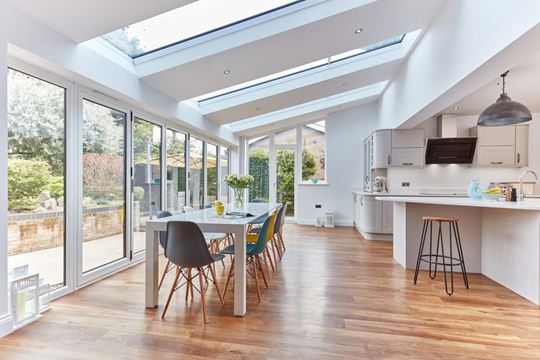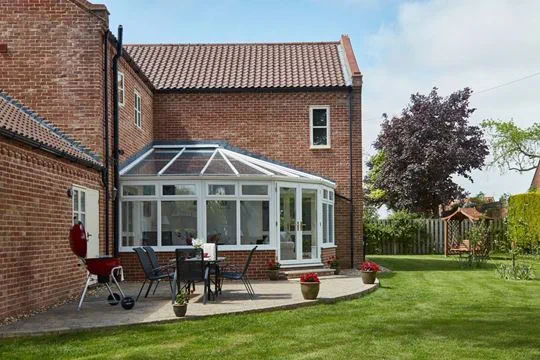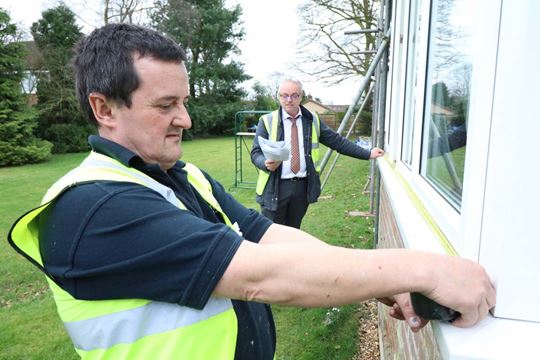It's exciting to add more space to your home and make it feel new again. Adding space can save you the trouble of moving. But with so many options, it's hard to know where to begin.
Should you choose an orangery, conservatory, or extension? Each one has unique features that make it perfect for your home. Let's explore the characteristics of each and how they can benefit your home.
Conservatories are glass structures usually attached to the back of a home. It is mostly made of glass and separated from the rest of the house by doors and sometimes windows. Originally, conservatories were designed to help plants grow. Now, people also use them as living rooms, home offices, or dining areas.
In the past, conservatories had single glazing which made them too hot in summer and too cold in winter. Modern conservatories have double-glazing to keep a comfortable temperature all year. Our Solaroof technology for glass roofs helps prevent conservatories from getting too hot.
You can also have a conservatory with a solid roof. Combined with partial brick walls makes today's conservatories very well insulated. You can choose the same brick colour at the base and uPVC windows that match your existing windows.
In most cases, you don’t need planning permission for a conservatory. You won’t need building regulations approval if:
You always need to follow building regulations when you make additions to your home. This includes a new doorway to connect your living space with the conservatory.
Orangeries were once a feature reserved for stately homes. They were fully glazed structures like greenhouses for exotic plants. Today, they’re contemporary design features in many homes in Britain.
Orangeries have solid brick sections, sturdy brick pillars and glass roofs. The defining feature of a modern orangery is its vaulted glass roof. The corners of an orangery are solid and some have more walls than windows. They often have a large bifold door on one side that creates a unique indoor-outdoor space in the summer.
It all depends on you and the design you want for your home. Orangeries are more solid structures while conservatories have more glass. An orangery is often warmer and provides a larger, more grand room than a conservatory. Conservatories also tend to have a connecting door separating it from the house. Orangeries have a wide opening instead of a doorway.
A sun room is another term for a glass conservatory. Sun rooms are conservatories attached to the part of a property that gets the most sunlight. A connecting door typically links these rooms to the home. A modern orangery is more solid in structure with a large, vaulted glass roof. It is a solid showpiece extension, often used to create an open plan kitchen-diner.
Structural additions like orangeries need to follow buildings regulations. This is because they need foundations. They create a new opening and share heating and electrics. Your builder should be aware of this, but it's also a good idea to do your homework.
An extension is a structural addition to your home that adds extra rooms or extra floors. Popular house extensions in Britain are at the back or side of a property, or loft conversions. Orangeries and conservatories are usually connected to your garden. Extensions don't have to be.
We offer single-storey extensions at the back or side of your home. You can customise the size and shape of your extension with a wide range of door, window and roof options. You may need planning permission and building regulation approval.
So, what's the difference between a conservatory and an extension? An extension has solid, insulated walls and a roof, making it fully integrated with the home. A conservatory is largely made of glass, so it’s less insulated.
What makes an extension different to an orangery then? Orangeries are usually one room, while an extension can add multiple rooms. An extension has a solid, insulated roof, whereas an orangery has a glass roof.
You must get approval for your extension from the building regulators for an extension. This approval covers the following areas:
You should also be aware of Part O of the building regulations. It focuses on reducing overheating in houses by:
This means that windows and glazed areas in extensions must be a certain size based on:
Now you know the difference between conservatories, orangeries and extensions. But how do you decide which is best for you?
What you want to do with the new space will determine the type of renovation you should choose. An extension is a good way to add more than one room, like a utility room and bathroom or a study and garden room. If you want to add one larger room for with lots of light, like an open plan kitchen-diner, then an orangery is best. If you want to create a new space to relax or entertain in, a conservatory is a good option.
A single-storey extension may be the natural fit if you have decent outside space at the back of your home. If you have room in your garden, you can increase your living space indoors or create the kitchen of your dreams. You can also extend to the side of your home if you have the space.
Conservatories and orangeries can work well with awkward spaces. They can be custom designed around the space you have available. They could replace a small patio or an odd-shaped piece of lawn. You can do so much with a small floor area.
If you have a big garden, you can add more rooms to your house by building an extension at the back. You can also extend to the side if there is enough space.
Every budget is different and conservatories, orangeries and extensions come with different costs. Conservatories are often the cheapest option of the three. If you're looking to add a little more space then this might work for you.
An orangery can be quite expensive, given the large glass roof and the size. If you want to add a true statement that creates a new space or enlarges an existing one, this ticks all the boxes. That said an orangery can add more value and last longer than a conservatory.
Single-storey extensions are often the larger and more expensive option. They are perfect for adding more practical space to your home with more than one room. Depending on how you use it, an extension can increase the value of your home by 5-10%. This can be more value than a conservatory would add.
We have been helping homeowners to create their dream homes for over 55 years. Whether you want a conservatory, orangery, or extension, all are made in Britain.
Our work complies with building regulations. We also take care of any planning applications.
Looking for inspiration for your home? Discover our conservatories, orangeries and extensions online.
 Styling your conservatory
Styling your conservatory
Adding finishing touches to your conservatory is the best part! Here, we give you tips on the best flooring, lights and even plants to add to your new living space.
 Fitting a conservatory into difficult spaces
Fitting a conservatory into difficult spaces
Big, small or awkwardly-shaped spaces are no match for an Anglian conservatory. Here, we'll show you how to fit a conservatory into any space, no matter the constraints.
 Getting planning permission for a conservatory
Getting planning permission for a conservatory
Securing planning permission for your conservatory is easier than you think. Anglian will help you every step of the way – we'll even submit the paperwork!


